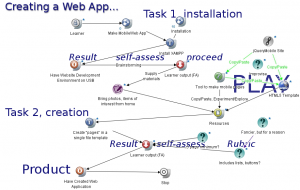Do you like maps? I know they’re not everyone’s cup of tea. But especially the kind of map you might draw for someone to get to your party, where they get to choose their own way in—depending where they’re coming from. Just over a year ago I began seriously researching learning design tools and techniques that might work well for Internet-based collaborations creating project-based learning experiences. I didn’t expect to still be at it a year later—and I definitely didn’t expect to become so thoroughly intrigued by a single class of software—I had no idea sophisticated, free, open source idea-mapping software existed.
Idea-maps can help plan an activity, can be an integral part of the activity, and can provide a map for those finding their way through the activity. They can leave a visual record that can be used to assess the activity, or the participants’ engagement and grasp of the activity.
I’m just not a linear thinker; a to-do list is perpetually the first thing on my to-do, list—if I can only remember where I left it! I’ve found “mind-mapping” software so useful I installed one on my iPhone, and I use it for planning everything from my day to my next big presentation. For my desktop and laptop I’ve found two immensely important programs useful. VUE is easy to use and has awesome meta-data and database abilities and a game-changing presentation tool, but the exported Web Maps become useless if you attempt to paste HTML in the fields (with my HTML skills I literally spent hours fixing this one, and I still haven’t got to the NE quadrant). Compendium has that covered, only it looks a lot like 1995. Both are open source, so a group with resources could fix either problem. Overall at least 90% of the things I want to create will be on the Web and contain HTML, so Compendium gets launched more. A group with resources at Open University UK has developed CompendiumLD, for Learning Design. It’s the one I use most.
When you have a map the maze is no longer a mystery and you can see through the walls of the labyrinth.
I designed an activity—creating a simple web app—and I’d like to know what you think of it. I’ve drawn a map, or you can dive right in.
In the activity you make a web app by copy and pasting code around your own idea or content. You have to install a web server to see your work (unless you already have one… and don’t mind missing out on the fun!). You may be very surprised by how easy that can be. You put it together in a fairly transparent way that should get it working for you quickly, and let you think about what you’re doing, or look into what you did, for a long while afterwards.
 The map tells you what to bring, where to go, what to do at each phase, and how to know if you’re on task, doing okay, ready to go on to the next step. I put the words in with an image editor (Gimp), I think they help but have yet to add them using the built-in text tool.
The map tells you what to bring, where to go, what to do at each phase, and how to know if you’re on task, doing okay, ready to go on to the next step. I put the words in with an image editor (Gimp), I think they help but have yet to add them using the built-in text tool.
Many people like to have a map. Some might prefer to jump straight in.
THE SOFTWARE, in their own words:
CompendiumLD learning design software. CompendiumLD is a software tool for designing learning activities using a flexible visual interface. It is being developed as a tool to support lecturers, teachers and others involved in education to help them articulate their ideas and map out the design or learning sequence. Feedback from users suggests the process of visualising design makes their design ideas more explicit and highlights issues that they may not have noticed otherwise. It also provides a useful means of representing their designs so that they can be shared with others. CompendiumLD provides a set of icons to represent the components of learning activities; these icons may be dragged and dropped, then connected to form a map representing a learning activity. http://compendiumld.open.ac.uk/
•
The Visual Understanding Environment (VUE) is an Open Source project based at Tufts University. The VUE project is focused on creating flexible tools for managing and integrating digital resources in support of teaching, learning and research. VUE provides a flexible visual environment for structuring, presenting, and sharing digital information. https://vue.tufts.edu/
•
Leave a Reply